
The Ultimate Guide to Copy Testing For Ecommerce Brands
Uncover the copy for your ecommerce website that converts visitors and builds a better customer experience.
Words make a difference. You might not realize it, but the language and phrases you use on your website can make or break the buying cycle. While it can be tempting to jot down a few sentences and hope for the best, making sure you nail your copy is crucial if you want to increase sales and forge deeper connections with your audience.
But how do you make sure you’re choosing the right words? It’s often a case of trial and error and tracking which combinations of words and phrases have the biggest impact. This is where copy testing comes into play.
What is copy testing?
Copy testing is the process of testing your copy. It’s a form of market research that identifies how successful your website will be based on visitors’ perceptions of the words you use.
It helps to understand what your customers actually want to know and pinpoints what terms and descriptions drive the most clicks, conversions, and sales. There are a number of different ways you can test your copy depending on how much time you have, what resources you have available, and what information you want to know.
While ad copy testing is commonly associated with marketing campaigns to determine the effectiveness of an advertisement on social media, for the purpose of this article we’re using it in the context of ecommerce brands and their websites.
Here are the four main types of copy testing:
1. A/B testing
A/B testing involves creating two identical pieces of copy but tweaking one element to make them slightly different. It might be changing the header or the phrasing of the call-to-action. Whatever the change is, it has to be small. This is so you can determine exactly which part of the copy makes a difference so you can build up a bigger picture over time of what works with your audience.
For example, you might create two of the same product page but alter the product title on one of them. You would then serve the pages to half of your audience each and see which one gets the best results.
Despite A/B testing giving you valuable information about specific parts of your copy, there are some downsides. It doesn’t tell you exactly why one variation was more popular than the other. On top of this, you need a significant amount of traffic to send a decent amount of views to each page.
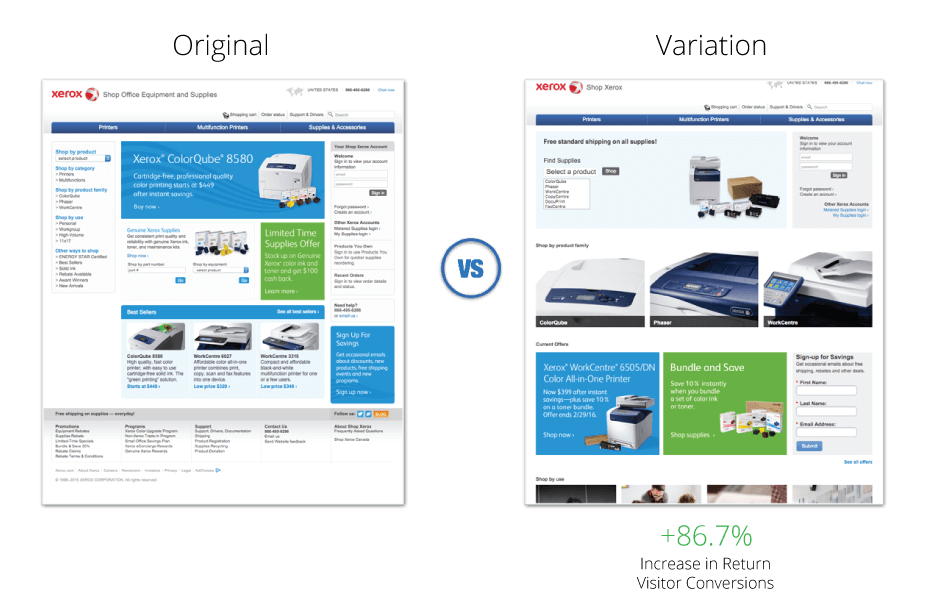
2. Multivariate testing
Where A/B testing trials two separate pages, multivariate testing shows visitors more than two variations. If you create three different CTAs and three different headlines, you can weave them together to make nine different page variations that you can then serve to different visitors. The best-performing one will show you the “winning” headline and the “winning” CTA.
We ran multivariate testing for Xerox, creating different versions of their product pages to see what worked best. By simply streamlining the layout and optimizing the CTA, we were able to generate an 86.7% increase in return visitor conversions.
3. Split testing
Split testing is similar to A/B testing in that you’re sharing two different pages with your audience, except this time the pages are totally different. You’re not just tweaking one element, you’re changing everything, from the header and description to the call-to-action and social proof.
4. User testing
User testing gets your audience involved and encourages respondents to answer questions about your copy to see what works best for them. There’s nothing quite like getting the information you need straight from the horse’s mouth, so to speak. Share your copy options with a handpicked group of your target audience and invite them to answer questions like:
- What did you think about that information?
- Would you change anything about it if you could?
- Were there any parts that were difficult to understand? If so, why?
- Can you summarize the information in your own words?
The goal of user testing is to determine whether the message you want to get across to readers actually works in real life.
How copy testing compliments conversion rate optimization
Copy plays a huge role in optimizing your conversion rates. While it’s just one part of the whole customer experience, it’s important for explaining your product to potential buyers and giving them the confidence they need to buy or get in touch.
Copy hooks shoppers from the start and takes them on a journey that presents your product or service as a solution to a problem they’re struggling with. Every part of the journey will involve copy in some way, from the headline to the product description to the CTA. When you test and optimize all these key ingredients, your conversion rates will increase.
For example, simply tightening up your CTA can make a huge difference – CTAs with 10 words or less have higher conversion rates than those with more.
Enjoying this article?
Subscribe to our newsletter, Good Question, to get insights like this sent straight to your inbox every week.
How to build a winning copy test in 4 steps
1. Set your overarching goals
What do you want to achieve with your copy testing? Chances are, you want to drive more conversions, but what does this look like in reality? How many more conversions do you want to generate each month? When doing any kind of testing, it’s important to set concrete goals so you know exactly what’s working and what’s not.
If you don’t have a goal in the back of your mind (or, ideally, written down somewhere), you won’t know whether it’s your new headline variation that’s causing a spike in purchases or whether it’s simply a seasonal surge.
So, the first thing you need to do is set a goal for your copy testing. It could be:
- Generate 10% more conversions
- Generate 150 new inquiries
- Increase revenue from a single product by 50% year-over-year
Note how these goals have concrete numbers and percentages attached to them. This makes them easy to measure – but remember to be realistic.
Think about the purpose of the individual page too. Product pages will have a different purpose than a product category page or a landing page for a specific deal.
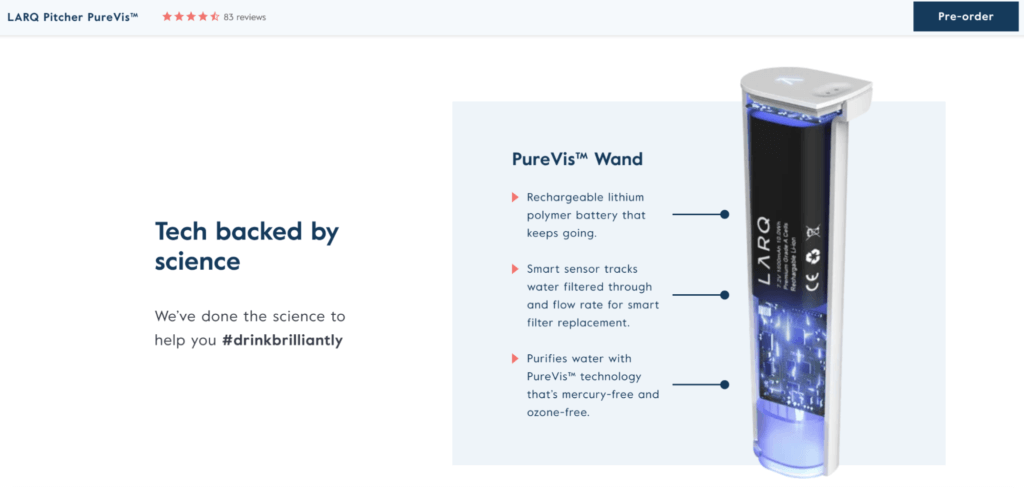
This product page from Larq (above) will have a different purpose to this About page information on Waterdrop’s website (below).
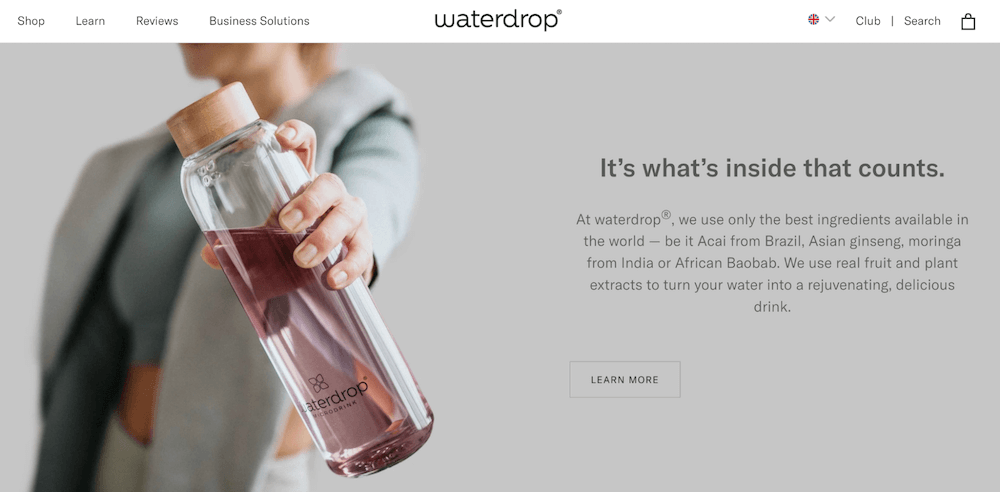
2. Choose your testing style of choice
We’ve listed the four most common types of copy testing above, but it’s up to you to determine which one you choose to go with (or whether you use a combination).
If you’re starting from scratch writing copy for a brand new product or a brand new page, multivariate testing is a good starting point. This will help you test out wildly different versions of the copy and see which one your audience prefers. From there, you can hone in further with split testing or A/B testing to tweak small parts of the copy, like the headline, CTA, or even the way you display pricing to see which ones perform best.
Finally, you can run your copy through user testing. Get a focus group together and create a list of deep-dive questions that will uncover what your audience thinks about the final versions of your copy and give you real-life test results to work with.
Do they understand what you’re trying to say? Could you be using better terms and phrases? How compelled do they feel to click the CTA?
3. Create the copy and its variations
This is the hard but fun part. Writing the copy (especially from scratch) can feel like a mammoth task, so it’s worth starting small. You have two options here:
- Write the copy yourself or get a team member to write it
- Bring a copywriter on board
A professional copywriter will be able to pare back your message and create a compelling page and multiple variations based on powerful copywriting techniques. Alternatively, you can give it a go yourself. Start by bulleting out the main things you want to say and creating different variations of each element. Play around with:
- The headline
- The subheader
- The introductory paragraph
- The product description
- The CTA
Again, consider the purpose of each page while you’re writing and the specific goals you’ve assigned. The blocks of content you include on different pages will vary. For example, a product page is likely to include a list of features and benefits, while a product category page is likely to be shorter and briefly list out information about the category and any additional information shoppers might need.
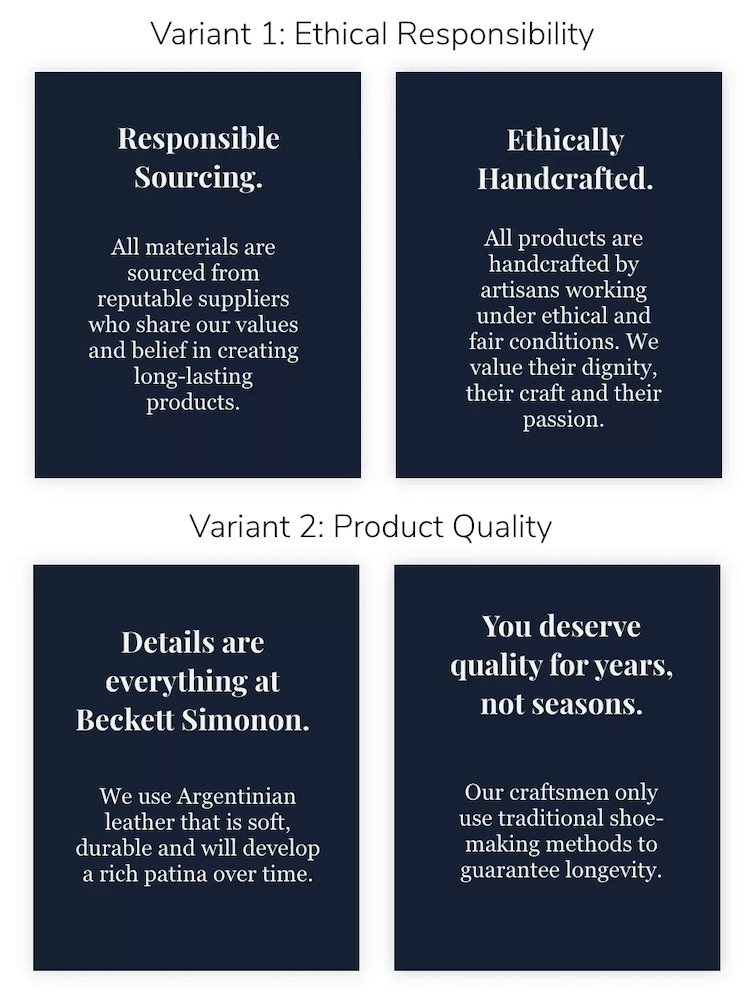
Beckett Simonon tested different messages with their copy about what differentiated them from other, similar brands.
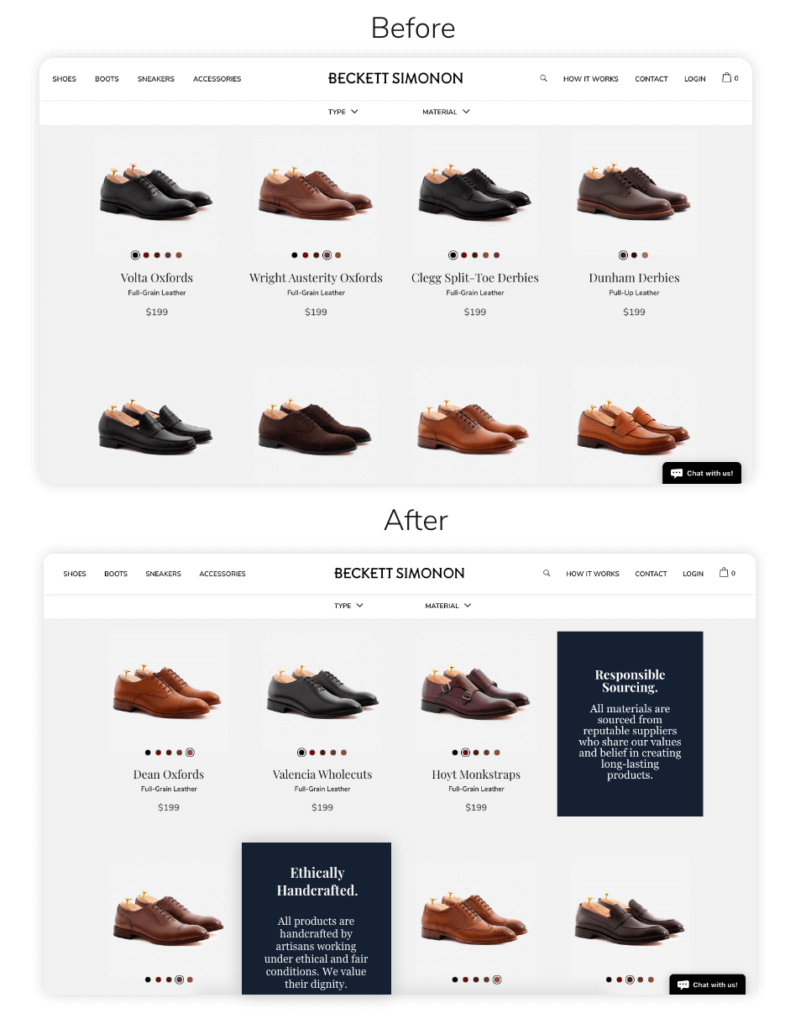
The copy was injected into product category pages to add the story behind the products. Doing this led to a 237% ROI over a year after the team realized that the additional copy variant generated a 5% higher conversion rate.
4. Test and test again
It’s important to continue to test your copy. The needs of your consumers will change over time and, the more you test, the more you’ll find out exactly what your audience wants from your website. Not to mention your conversion rates will increase.
While you want to give your copy time to settle and resonate with prospects, you also want to consistently come up with ways to improve it. For example, you might test different header variations every other month to see if there’s a better fit than the one you already have. Or, you might continuously run a multivariate campaign on your landing pages connected to your latest ad campaign.
Be sure to check in with your copy performance regularly – we can’t emphasize this enough! Track conversions, traffic, and clickthroughs to see what copy is a hit with your audience.
How to measure copy testing: 5 key metrics
You’ve got your copy written and ready to go, your goals are set in stone, and you’re eager to see the results — but how do you measure the efforts of your copy testing? Ultimately, this will depend on your goals and the purpose of the page.
However, here are some key metrics you can track to see how your copy is performing:
- User feedback: user feedback is a powerful way to learn exactly what your audience is thinking when they read your copy. Measure the success of your copy by asking shoppers for their feedback and identifying any common patterns.
- Clickthroughs: the number of people who click through to another page or continue to browse your site will determine how effective your copy is — are they taking the next steps you want them to? Are they navigating somewhere else to learn more? This could indicate that your copy isn’t giving them the information they need.
- Time on page: the longer a shopper stays on a page, the more likely it is that they like what they see. Compelling copy hooks readers from the start and encourages them to continue reading which leads to a longer time spent on site. Be careful, though, as too much time on site can indicate other challenges.
- Conversions: the ultimate test of your copy is the number of actual sales it generates. This will fall heavily on your CTA, but creating an engaging header and product description is also crucial.
- Heatmap data: eye-tracking with heatmap data reveals the sections of the page a customer spends the most time on. This will help you determine what they find most interesting or useful. If they spend a lot of time reading the product description or digging into the FAQs, you know that these elements are important.
Get started with copy testing today
Copy makes up a large part of your ecommerce website. Without it, shoppers won’t know why they should buy your products over a competitor’s. Testing out the words on every page will help optimize your efforts so that shoppers are hooked and engaged from the get-go.
A/B testing, split testing, multivariate testing, and user testing are all useful techniques for discovering what words resonate with your target market the most, giving you the information you need to tighten your copy and create conversion-powered pages across your site.
Use copy testing, and other testing methods, to improve your ecommerce website. Get started with our new book, Opting In to Optimization.

About the Author
Jon MacDonald
Jon MacDonald is founder and President of The Good, a digital experience optimization firm that has achieved results for some of the largest companies including Adobe, Nike, Xerox, Verizon, Intel and more. Jon regularly contributes to publications like Entrepreneur and Inc.